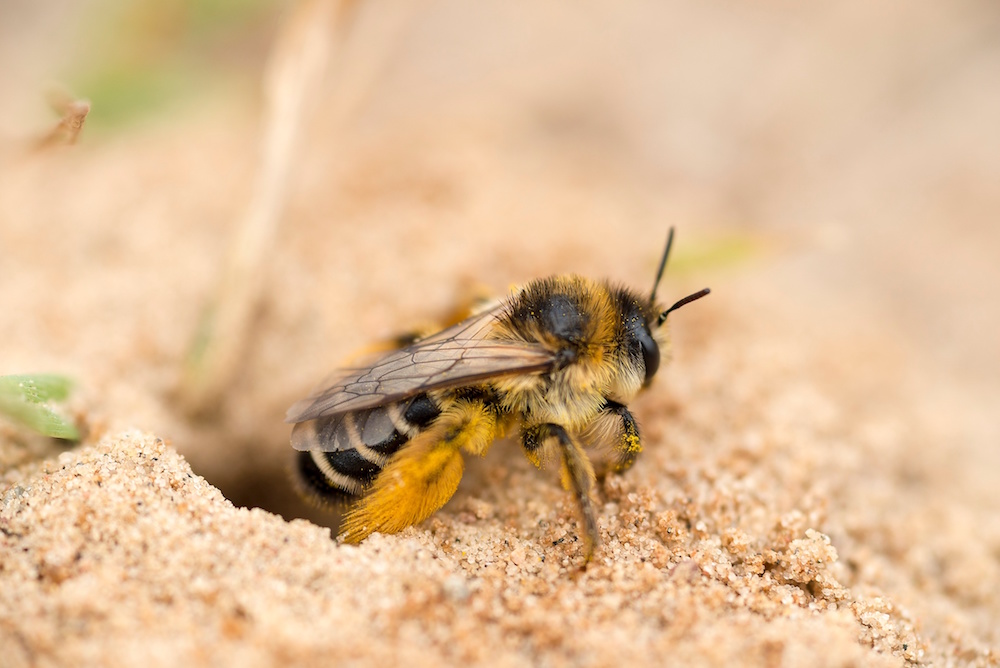What You Should Know About Mining Bees


Have you ever noticed bees going in and out of a hole in the ground? If so, you’ve seen mining bees! Many people don’t know much about these ground bees. In fact, most people mistake them for honey bees or wasps.
However, mining bees include over 1,300 species of bees in the genus Andrena, so they are much more common than you might think. We think it’s time to give mining bees their time in the spotlight! Let’s address some of the most commonly asked questions about mining bees so we can learn more about these fascinating creatures.
What You Should Know About Mining Bees
They are solitary bees.
Bees in the genus Andrena are solitary bees which means that they do not belong to a colony of bees. They do not have a large hive full of precious honey and a queen bee to protect. Female mining bees do all of the work throughout their life cycles. They build their own underground nests, lay the eggs and collect the nectar and pollen for the hatched eggs.
They are non-aggressive.
The idea of stepping on an underground nest sends many people into a state of panic, but mining bees are very docile. In fact, it would be extremely rare to be stung by a mining bee. The majority of the bees that you see hovering above a ground nest are males who do not even have stingers. The female stingers are quite small and would not cause much pain to humans.
They have a relatively simple life cycle.
Female mining bees will build their nests in the ground and then fill the cells with nectar and pollen. After laying her eggs, the female bee will die, leaving the eggs with the food source to help them develop into adult bees. In the early spring, the new mining bees leave the nest to mate and begin the process over again.
They are picky pollinators.
Mining bees are oligolectic which means that they only gather pollen from certain plant species. Some even collect pollen from only one plant species! These bees are called monolectic.
They will not damage your yard.
A lot of homeowners might be concerned that all of these underground nests will cause damage to their yards and plants. In fact, mining bees are some of our earliest pollinators and help garden plants and flowers flourish. Many people even agree that mining bees act as excellent yard aerators! Although the dirt mounds and holes might look unappealing, these underground bees won’t cause destruction to your yard.
What to Do If You Find Mining Bees on Your Property
One of the biggest questions we get when it comes to mining bees is “How do we get rid of them?” The best answer is simple: just let them be!
Mining bees are not usually a danger to people, pets or property. There have even been countless reports of people walking barefoot in grass that is full of mining bees without getting stung once. And because these bees have a relatively short lifespan, they are usually only buzzing around for about 4 to 6 weeks.
If you believe that they are causing damage or harm, never use pesticides to rid your home of the problem. Pesticides are unsafe for people and will kill other types of beneficial bees and insects. It is also never recommended that you try to dig them up or cover the entrances to their nests. The best course of action is to call professional bee removal specialists who can diagnose the issue and suggest the best solution for your situation.
Have More Questions About Mining Bees or Honey Bees?
We love helping our customers in the San Diego area learn more about bees. If you have more questions about mining bees, honey bees or any type of bee, give our specialists a call! D-Tek Live Bee Removal has been in the live bee removal business for almost 15 years. Our team has some of the best bee removal pros in the area that know how to assess your bee issue and recommend the best and most cost-effective solutions.
Do you need help ridding your home or business of bees? Contact us today to discuss our professional live bee removal, bee removal repair and bee proofing services for residents of San Diego and the surrounding communities.
